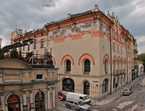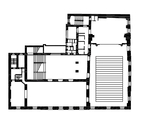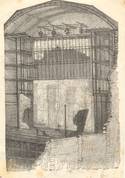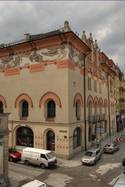Helena Modrzejewska National Old Theatre
Szczepan Humbert
alias Stary Teatr (The Old Theatre, 1941-1944, 1945-1946, 1954-1956), Teatr Krakowski (The Krakow Theatre, 1842-1893), Teatry Dramatyczne Kraków – Stary Teatr (Drama Theatres Krakow – The Old Theatre, 1946-1954), The Helena Modrzejewska Narodowy Stary Theatre, without official name (1799-1842), Stary Teatr im. Heleny Modrzejewskiej (Helena Modjeska’s Old Theatre, 1956-2001)ul. Jagiellońska 5 | |
| show on the map | http://www.stary-teatr.krakow.pl/ |
Important events
Tadeusz Stryjeński (29.08.1849 – 3.06.1943) – architect, constractor.
http://www.muratorplus.pl/biznes/firmy-i-ludzie/tadeusz-stryjenski-czyli-architektoniczna-osobowosc-krakowa_63646.html
Franciszek Mączyński (2.09.1874 – 28.06.1947) – architect, restorer.
http://palac-sztuki.krakow.pl/franciszek-maczynski-architekt-tworca-palacu-sztuki/
People
History
The oldest preserved theatre building, Narodowy Stary Teatr im. Heleny Modrzejewskiej (Helena Modjeska’s National Old Theatre) in Kraków, used to be the private property of prefect Jacek Kluszewski[1], who used two of his tenement houses in Jagiellońska Street for this purpose in 1798. City architect Szczepan Humbert placed the entrance in the narrow Jagiellońska Street, where it remains to this day, while the green neoclassical façade extended along Szczepański Square. The edifice has been compared to many European theatres (including to the Royal Astley Theatre in London and to the Teatro Tonido in Venice), and the interior was patterned on the Leopold-Theatre in Vienna[2]. The stage of the Kraków theatre was shallow (just 5.5 m including the proscenium), with modest equipment and infrastructure. The rectangular house was surrounded by boxes and two balconies. The places in the stalls were for standing spectators (naturally male and well-born, because places for the plebs were in the gods). As was the habit, a redoubt room was located in the theatre. Since, following the third partition of Poland (1795), Kraków found itself in the Austrian area, German troupes exclusively performed in Kluszewski’s edifice. Only guest performances from the National Theatre from Warsaw, under Wojciech Bogusławski’s direction, saw the start of regular Polish performances in 1809. After Kluszewski’s death, the authorities of the Free City of Kraków bought the theatre in 1842 and gave it a major renovation and enlargement. This renovation came at a critical moment, because, as Hilary Meciszewski, the director and reformer of this theatre between 1843 and 1845, maliciously put it, “what we used to call the theatre in Kraków over 20 years ago, was as similar to the theatre, as a monkey is similar to man” [3]. Meciszewski pointed out what was needed to make the art of drama “a worthwhile objective”. “It should primarily have a temple, worthy of its worship” [4]. It will come as no surprise then, that Karol Kremer and Tomasz Majewski, while designing the new façade followed the pattern of the Medici palace in Florence. Now the four-storey auditorium filled the whole height of the edifice (along Szczepański Square) and could accommodate 900 spectators. The decorations were highly praised. On the plafond, oval portraits of Shakespeare, Schiller, Goethe and Moliere were painted among plant ornaments, while boxes were embellished with images of Polish playwrights. The chandelier, the curtain and several sets of scenery were ordered from famous theatre painter Carl Wilhelm Gropius in Berlin. The most admired were the sets for “The Virgin of Orleans” by Schiller, depicting the cathedral of Reims on fire. In fear of real fire, wooden stairs were placed against the façade in 1882 (for evacuation purposes, such stairs were raised in many European theatres after the tragic fire in the Viennese Ringtheater in 1881). As the theatre was dilapidated, the authorities of Kraków decided to erect a new edifice. The last performance in Szczepański Square, before the company moved to Św. Duch Square, took place on 31 August 1893.
However, the old edifice was not demolished. The city authorities decided to install a concert hall and ballrooms there. Therefore the whole interior was rearranged, under the direction of Tadeusz Stryjeński and Franciszek Mączyński. A concert hall was installed on the first floor (currently there is a theatre in this place), leading in through wide stairs from an enlarged vestibule. On the right (also on the first floor) there was a redoubt room, used for various purposes. The art nouveau exterior was designed by sculptor Józef Gardecki, and the reconstruction was finished in 1906. Apart from concerts, there were also occasional theatre performances here. Stary Teatr owes its return to its previous function to the Germans, who decided to install their drama company here during World War II, and had the concert hall rebuilt. Thanks to this, the theatre reopened in 1945. Since that time the building has undergone fairly frequent modernisations, always maintaining the traditional layout of the stage and the auditorium. However, this has not prevented artists from decomposing this space. A performance of Dziady (Forefathers' Eve) by Adam Mickiewicz, directed by Konrad Swinarski (1973), whose statue embellishes the theatre hall, went down in the history of the Old Theatre. The scene of invoking ghosts was performed among the spectators in the staircase and in the foyer. Then the dramatic action transferred to the proper room, where a cross-shaped stage was in place. Here, as in the medieval mystery play, the Guardian Angel and the (black) Ghost appeared on opposite sides.
The renovated neoclassical facade, dating back to the times of Jacek Kluszewski, the creator of this shrine, acts as a glorious reminder of the more than two hundred year long history of the this building in Szczepański Square.
Artists: Carl Wilhelm Gropius (designer of curtain); Andrzej Lisowski (painting decoration of a part of interior), Aumajer (decorating the interior while rebuilding lead by Karol Kremer and Tomasz Majewski), Jan Gardecki (stucco bas-relief placed over the balcony, presents „sacral music” as well as „sacred music” – since the German occupation, the bas-relief hasn’t existed)
Architect: Szczepan Humbert
Construction: 1798-1799
Reconstructions: 1841-1842, Karol Kremer and Tomasz Majewski (renovation of the roof, stage and auditorium, new decoration of the façade, connecting old building with new building, which was bought for the purpose of theatre extension); 1878 (replacing steps under the balcony with a ramp, changing the boxes arrangement, new separate entrance onto the first floor boxes, new entrance from the first floor); 1903-1906, Tadeusz Stryjeński and Franciszek Mączyński (new façade, rebuilding of the main hall); 1943-1944, Bronisław Opaliński and Marcin Bukowski (renovation of the building, new technical equipment, new dressing rooms)
Literature:
- Adwentowicz K., Wspominki, Warszawa 1960.
- Balicki S. W., Ludzie „Dziennika Polskiego" zapamiętani wczoraj i widziani dziś, „Zeszyty Prasoznawcze" 1964, nr 3.
- „Biuletyn Informacyjny Wojewódzkiego Wydziału Kultury i Sztuki" 1946, nr 1,
- Chomiński J., Muzyka Polski Ludowej, Warszawa 1968. Studia o Polce współczesnej. Kronikę życia muzycznego w Polsce w latach 1945—1966 opt. I. Poniatowska.
- Csató E., Polski teatr współczesny pierwszej połowy XX wieku, Warszawa 1967.
- G a w l i k J. P., Twarze teatru, Wrocław 1963.
- K o s i ń s k i J., Kształt teatru, Warszawa 1972.
- Kosiński R„ Głowy podwawelskie, Kraków 1965.
- Nowacki K., Dzieje teatru w Krakowie. Architektura krakowskich teatrów, WL, Kraków 1982.
- Orzechowski E., Stary Teatr: pierwsze kłopoty i skandale, „Zycie Literackie" 1972, nr 45.
- Sto lat Starego Teatru w Krakowie. Praca zbiorowa dla uczczenia setnej rocznicy objęcia dyrekcji przez Adama Skorupkę i Stanisława Kożmiana, Kraków 1965.
[1] An entrepreneur of the Cracow theatre in the years 1787-1830, he moved the company to their own seat, which has been used by the Old Theatre to this day. Despite the complicated political situation and the dependence on the Austrian authorities, this enterprising man managed to establish a theatre that was national in character and which performed not only in Cracow, but elsewhere.
[2] Barbara Król-Kaczorowska, Teatr dawnej Polski. Budynki, dekoracje, kostiumy, Państwowy Instytut Wydawniczy, Warszawa 1971, p. 51.
[3] Kazimierz Nowacki, Dzieje teatru w Krakowie, Architektura krakowskich teatrów, Wydawnictwo Literackie, Kraków 1982, p. 82.
[4] Ibidem.
Author: Anna Kuligowska-Korzeniewska
Additional information
No information has yet been entered
Add information

































